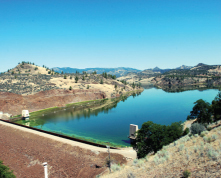Chapter Review
58
THINGS TO KNOW
5.1 Area
Definitions:
- Partition of an interval [a,b] (p. xx)
- Area A under the graph of a function f from a to b (p.xx)
5.2 The Definite Integral
Definitions:
- Riemann sums (p. xx)
- The definite integral (p. xx)
- ∫aaf(x)dx=0 (p. xx)
- ∫baf(x)dx=−∫abf(x)dx (p. xx)
Theorem: If a function f is continuous on a closed interval [a,b], then the definite integral ∫baf(x)dx exists. (p. xx)
- ∫bah dx=h(b−a), h a constant
59
OBJECTIVES
| Section | You should be able to … | Examples | Review Exercises |
|---|---|---|---|
| 5.1 | 1 Approximate the area under the graph of a function (p.xx) | 1, 2 | 1, 2 |
| 2 Find the area under the graph of a function (p.xx) | 3–5 | 3, 4 | |
| 5.2 | 1 Define a definite integral as the limit of Riemann sums (p. xx) | 1–2 | 5(a), (b) |
| 2 Find a definite integral using the limit of Riemann sums (p. xx) | 3–5 | 5(c), 6 | |
| 5.3 | 1 Use Part 1 of the Fundamental Theorem of Calculus (p. xx) | 1–3 | 7-10, 59 |
| 2 Find a definite integral using Part 2 of the Fundamental Theorem of Calculus (p. xx) | 4, 5 | 5(d), 11–13, 17, 18, 63 | |
| 3 Interpret an integral using Part 2 of the Fundamental Theorem of Calculus (p. xx) | 6 | 21, 22 | |
| 5.4 | 1 Use properties of the definite integral (p. xx) | 1–6 | 15, 16, 23, 24, 27, 28, 60, 64 |
| 2 Work with the Mean Value Theorem for Integrals (p. xx) | 7 | 29, 30 | |
| 3 Find the average value of a function (p. xx) | 8 | 31–36 | |
| 5.5 | 1 Find indefinite integrals (p. xx) | 1 | 14 |
| 2 Use properties of indefinite integrals (p. xx) | 2, 3 | 19, 20, 37, 38 | |
| 3 Solve differential equations involving growth and decay (p. xx) | 4, 5 | 39, 40, 66, 67 | |
| 5.6 | 1 Find an indefinite integral using substitution (p. xx) | 1–5 | 42–45, 49, 50, 53, 54, 57, 58 |
| 2 Find a definite integral using substitution (p. xx) | 6, 7 | 46–48, 51, 52, 55, 56, 61, 62 | |
| 3 Integrate even and odd functions (p. xx) | 8, 9 | 25–28 | |
| 4 Solve differential equations: Newton's Law of Cooling (p. xx) | 10 | 65 |
CHAPTER 5 PROJECT Managing the Klamath River

There is a gauge on the Klamath River, just downstream from the dam at Keno, Oregon. The U.S. Geological Survey has posted flow rates for this gauge every month since 1930. The averages of these monthly measurements since 1930 are given in Table 2. Notice that the data in Table 2 measure the rate of change of the volume V in cubic feet of water each second over one year; that is, the table gives dVdt=V′(t) in cubic feet per second, where t is in months.
| Month | Flow Rate (ft3/s) |
|---|---|
| January (1) | 1911.79 |
| February (2) | 2045.40 |
| March (3) | 2431.73 |
| April (4) | 2154.14 |
| May (5) | 1592.73 |
| June (6) | 945.17 |
| July (7) | 669.46 |
| August (8) | 851.97 |
| September (9) | 1107.30 |
| October (10) | 1325.12 |
| November (11) | 1551.70 |
| December (12) | 1766.33 |
Question 5.15
Find the factor that will convert the data in Table 2 from seconds to days. [Hint: 1 day =1d=24 hours =24h(60min/h)=(24)(60)min (60s/min).]
If we assume February has 28.25 days, to account for a leap year, then 1 year =365.25 days. If V′(t) is the rate of flow of water, in cubic feet per day, the total flow of water over 1 year is given by V=V(t)=∫365.250V′(t)dt.